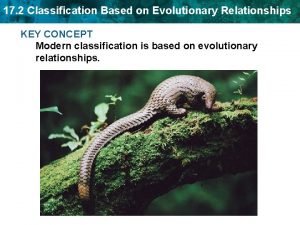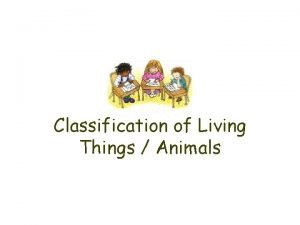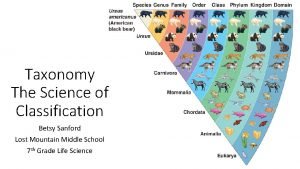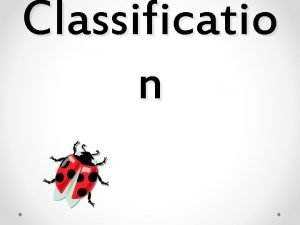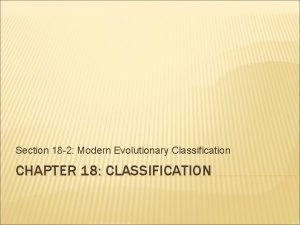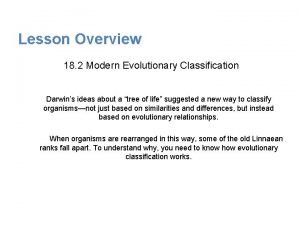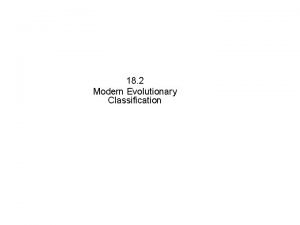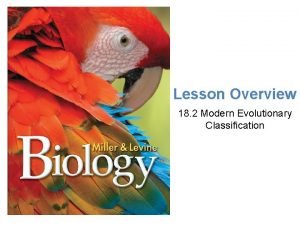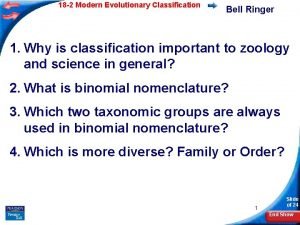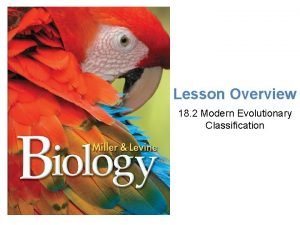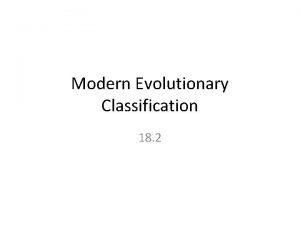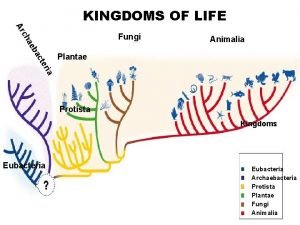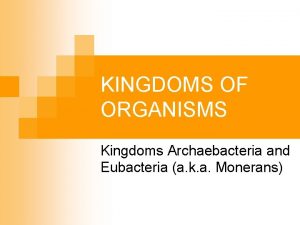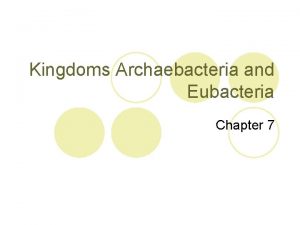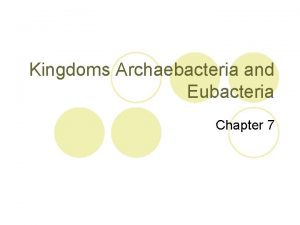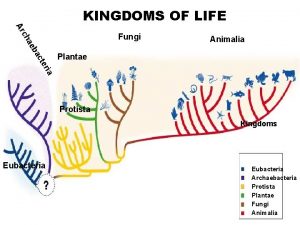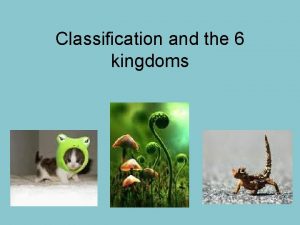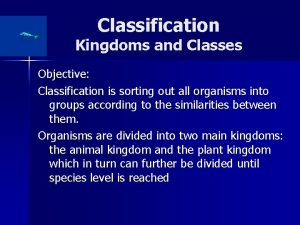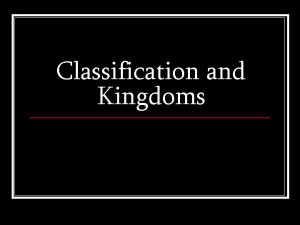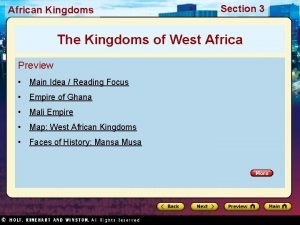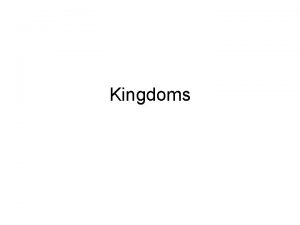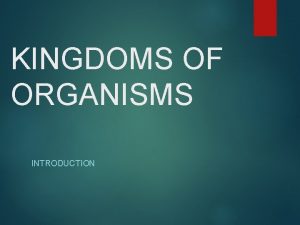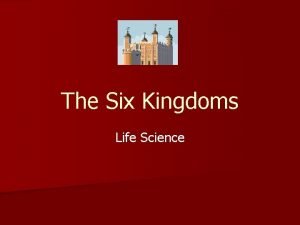Classification The Kingdoms Evolutionary relationships and classification Evolutionary






















- Slides: 22

Classification The Kingdoms.

Evolutionary relationships and classification. • Evolutionary relationships are determined by similarities in • body structure • breeding behavior • Geographic distribution. • Chromosomes. • These keys provide the evidence that these organisms are related.

Structural similarities. • Shared structural similarities indicates that these species are closely related and descend from a common ancestry. The lynx and the bob cat share similar structures and that suggest that they descended from a common ancestry, e. g. • Ear tufts • Spotting on their coat. • Short tail • Back legs longer than the front legs.


Breeding behavior • Organisms that live in the same area and have similar breeding habits are normally related. • The Hyla versicolor and the Hyla chrysoscelis are two species of frogs that look similar but their mating calls are different.

Geographic distribution • The location of species on earth helps biologists determine their relationships with other species. • The finches that live on the Galapagos islands are similar to the finches that lived on the south American mainland.

Genetic comparisons • The chromosomal number and structure during mitosis and meiosis are similar in cabbage, kale, broccoli and cauliflower. Biologists suggests that they all came from a common ancestry.

Phylogenic classification models. • Species that descend from a common ancestry also share a common evolutionary history. The evolutionary history of an organism is called its Phylogeny. •

cladistics • Scientists believe that organisms evolved from one common ancestry. Taxonomist use these traits that they inherited to make a cladogram. • Branches on these cladograms show similar ancestry. On a cladogram, diverging branches share a more recent ancestor than branches farther away.

The Six Kingdoms of Organisms • The six kingdoms of life are, • Archaebacteria • Eubacteria • Protists • Fungi • Plants • Animals. • The difference in cell structure and methods of obtaining energy are the two main characteristics that separate these kingdoms.


Prokaryotes • Prokaryotes are small organisms that lack have membrane bound organelles, e. g. nucleus or mitochondria. The two kingdoms of prokaryotes are, • Archaebacteria • Eubacteria

Archaebacteria • There are hundreds of species of archaebacteria and most are found in swamps, deep oceans and hydrothermal vents. These environments lack oxygen which suits the archaebacteria.

Eubacteria. This kingdom consists of about 500 species of bacteria. Their less genetic makeup is less complex and they have a strong cell wall. They can also be found is most habitats and may cause diseases such as pneumonia and strep throat.

Diseases caused by bacteria

Protista • A protest lacks a complex organ system and lives in moist habitats. Some protista are made up of one cell, while others are multicellular. • Some protista are plant like and make their own food while others depend on others for food.

Types of Protists

Fungi • Organisms in the Fungi kingdom depend on other organisms for food (heterotrophs) and do not move from place to place. A fungus absorbs nutrients from dead or decaying organisms in the environment. There are over 500 species of fungi known today.

Fungal Structures

Plants • Plants are made up of more than one cell ( multicellular), make their own food and do not move from place to place. • A plant cell contains chloroplast and cell wall. Plants first existed 400 million years ago. We can classify plants as mosses, ferns, evergreen, flowering and nonflowering.


Animals • Animals are multicellular heterotrophs that move from place to place. Animal cells do not have cell walls; however they are organized into tissues that form complex organ systems. These systems include, digestive, skeletal, muscular, reproductive etc.
 Based on evolutionary relationships
Based on evolutionary relationships Classification based on evolutionary relationships
Classification based on evolutionary relationships Protistia
Protistia Invertebrates animals
Invertebrates animals Genus family class order
Genus family class order Levels of classification
Levels of classification Six kingdom
Six kingdom 18-2 modern evolutionary classification
18-2 modern evolutionary classification 18.2 modern evolutionary classification answers
18.2 modern evolutionary classification answers 18-2 modern evolutionary classification
18-2 modern evolutionary classification Section 18-2 modern evolutionary classification
Section 18-2 modern evolutionary classification Red panda life cycle
Red panda life cycle Wolf classification
Wolf classification Modern evolutionary classification
Modern evolutionary classification Hát kết hợp bộ gõ cơ thể
Hát kết hợp bộ gõ cơ thể Ng-html
Ng-html Bổ thể
Bổ thể Tỉ lệ cơ thể trẻ em
Tỉ lệ cơ thể trẻ em Chó sói
Chó sói Tư thế worm breton
Tư thế worm breton Hát lên người ơi alleluia
Hát lên người ơi alleluia Các môn thể thao bắt đầu bằng tiếng nhảy
Các môn thể thao bắt đầu bằng tiếng nhảy Thế nào là hệ số cao nhất
Thế nào là hệ số cao nhất
